Here at Fabric of Paris, January is an opportunity to look back at the past year’s transport developments and to get excited about what’s in store for the coming year. Last week, we looked at national and international rail services from Paris. But there are lots of interesting things happening in the local transport network. Let’s dive in.
Tramways
2023 saw the opening of two brand-new tram lines in the Île-de-France region.
T10
Line 10 opened in June. It’s a conventional tramway reminiscent of line 9, which opened two years earlier: the stops are similar in design, and it uses the same Alstom Citadis 405 rolling stock. The line runs through the southern part of the Hauts-de-Seine department, which can be qualified as “inner-suburban”, of moderate population density by regional standards. It offers connections with RER line B, tramway line 6 and bus rapid transit line Tvm. There will be no sharing of vehicles between the tramways: line 6 runs on rubber tyres.
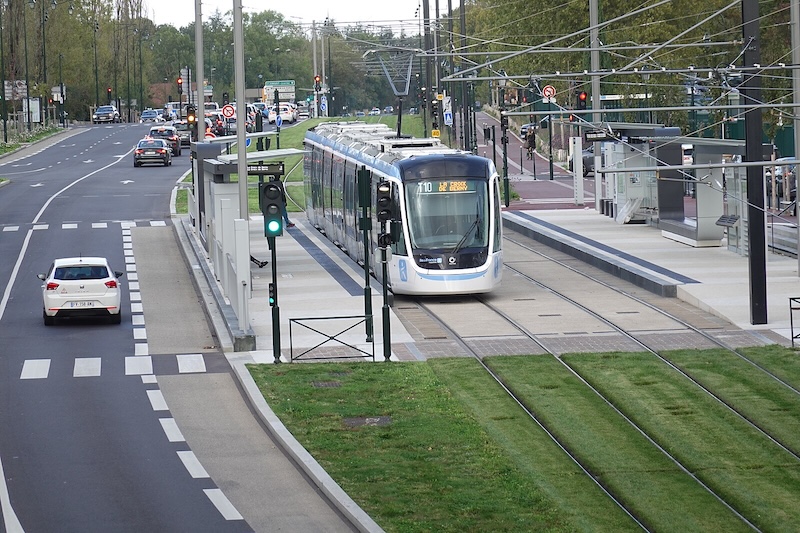
The opening of line 10 was marred by riots days later, in which one of its trams in Clamart was set alight. The riots, a difficult start to the French summer, were triggered by the shooting dead of a 17-year-old by police in nearby Nanterre.
Like most of the region’s tramways – but unlike line 9 – it is operated by Paris’s historic transport company, RATP. As with all new lines, trams are liveried in the colours of the regional authority, Île-de-France Mobilités.
T12 Express
2023’s other new tramway opened in December, several kilometres further south in the department of Essonne. This one is a tram-train line: vehicles run as trams south of Petit Vaux, while to the north they operate on the Grande Ceinture railway line, formerly part of RER line C. On the railway, they run on the left, as is standard for mainline trains in France; on the remaining section, they are driven on the right, in common with other road vehicles.
The low-floor vehicles, Alstom’s Citadis Dualis, are capable of drawing from either a 1500 V DC power line (used on this part of the Grande Ceinture) or a 750 V DC line (used on most French tramways). But in a departure from the norm for tramways, the entire line uses the same 1500 V standard.
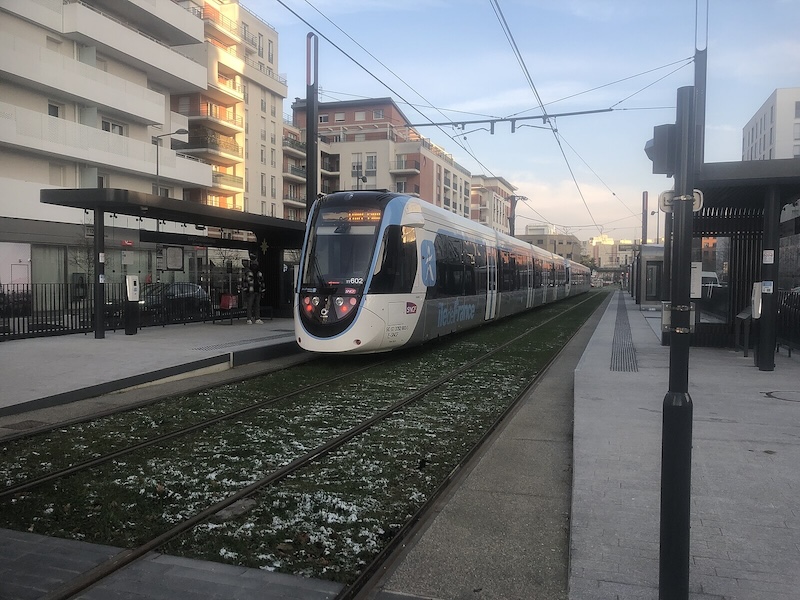
This is the third “express” tramway line, operating over parts of the Grande Ceinture. It’s the fourth line on the network to use tram-train vehicles and infrastructure that belongs to the national railway. But it’s arguably the region’s first true tram-train, in that it’s the first to actually share track with other services: both long-distance passenger and freight trains.
The T12 provides a welcome new link between the urban centres of Massy and Évry. However, it’s resulted in degraded service for people on the stretch of RER it’s appropriated. Connections involve rather too much walking, especially at Évry. And a shortage of drivers has led to headways of 15 minutes and sometimes even worse. The timetable isn’t synchronised with that of the RER, leaving people with a new waiting period where once their journey towards Paris was direct.
On the other hand, an important goal of the new line was to simplify service patterns on the notoriously confusing and unreliable RER C. The ultimate plan will take the line west from Massy all the way to Versailles, though the timetable for that is uncertain. A degree of simplification has nonetheless been achieved.
Upcoming developments
2023 brings to a close an extraordinary period of tramway expansion. At the beginning of 2013, the network counted just 5 lines. At the beginning of 2021, that had increased to 10. Three years later, there are as many as 14. But there are no plans for entirely new lines in the foreseeable future.
That said, we can still expect important developments in the coming years. In spring 2024, line 3b will be extended to Porte Dauphine.
Tram line 3 first opened in 2006. In 2012, it was extended to Porte de Vincennes and renamed 3a, with a new sister line, 3b, continuing around the city’s eastern frontier. The latter was extended in 2018 to the north west. This year’s extension, through the 17th and into the 16th arrondissement, might be the last, leaving an open loop from the new terminus to the Seine. Closing the circle is unpopular with residents of this affluent, relatively car-dependent part of town. But extending the 3a to meet the 3b would create connections with metro lines 9 and 10.
The extension to Porte Dauphine connects with metro lines 1 (at Porte Maillot) and 2 (at the new terminus). As elsewhere, the creation of the tramway has allowed the redevelopment of the road junctions along the route, many of which are dangerous roundabouts. This is especially true at Porte Maillot, which is being completely transformed to the benefit of pedestrians. It’s an important destination, the site of the Palais des Congrès, which houses a conference centre, performance venue, shopping mall and hotel.

The final piece of exciting tram news for 2024 is the arrival of the first new vehicles on line 1. This line opened in 1992, the first in a new generation of tramways. Once a pioneer, today it has the oldest rolling stock on the network. This year, that changes. At the same time, the existing line is being upgraded as it prepares for extensions at both ends in 2025 and 2027. Too long to operate as a single line, it will be broken into three segments.
Regional rail
Changes to line C
While we wait for the T12 to be extended to Versailles, the stretch of RER line C west of Massy has been broken off to form a shuttle. This is nothing new: line D has a similarly detached suburban segment, as do Transilien lines H, P and R1. What’s new this time is that the new section has been rebranded, to form the new Transilien V.
I welcome the extra clarity this brings. But the obvious question arises: why not do the same for the similar branches elsewhere? The Esbly-Crécy branch of line P uses the same rolling stock as the region’s tram-train lines, so a case could be made for renaming it T14. The others could take W, X and Y. The only issue is that that doesn’t leave a lot of scope for new lines unless we start using another alphabet. My vote is for Egyptian hieroglyphs.
The advent of line V removes the bizarre Versailles-Versailles service from the RER C, and the accompanying confusion for château-bound tourists. Take the wrong Versailles train, and you could find yourself snaking through the fields of Essonne to arrive at a station some distance from your destination.
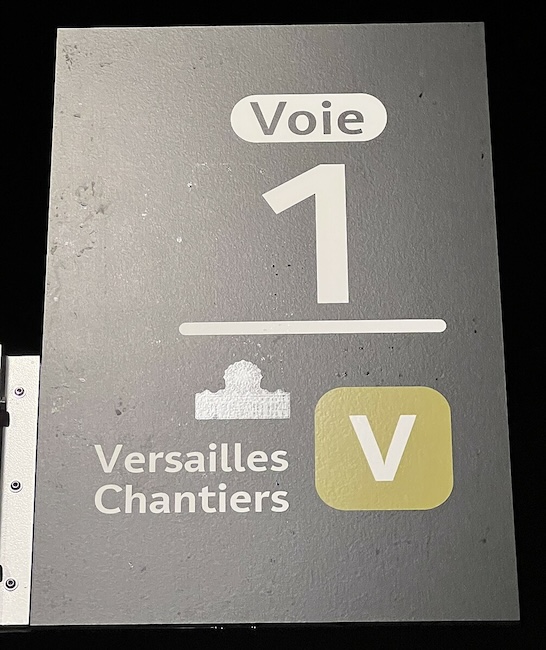
Westbound extension of line E
RER line E opened in 1999, linking the eastern suburbs with the Gare du Nord and the central business district at Haussmann – Saint-Lazare. It was intended the line would eventually continue westwards, taking over suburban railways all the way out to Mantes-la-Jolie in the outer reaches of Île-de-France. Final plans, which would include new stations at Porte Maillot, La Défense and Nanterre, scheduled the opening for 2020. This was later adjusted to 2022. As of 2020, the plan was for trains to serve Nanterre from 2023 and reach all the way to Mantes in 2024. As it stands today, there will be a very partial opening in April 2024 – with four trains an hour in off-peak hours and none at all in the peak – and a full opening to Nanterre in October. For Mantes, we’ll be waiting until at least the end of 2026.
This RER extension is a huge project. It will offer a direct route from the Gare du Nord to the La Défense business district, where engineers managed to create space for an ample station in a dense underground environment of existing transportation and the foundations of skyscrapers. It will also be central to a new hub at Porte Maillot, where it will join the newly extended tramway.
RER rolling stock
Line E welcomed its first swanky new RER NG trains in November 2023. This year, they will arrive on line D. Heavily delayed by funding issues, and in particular by problems at manufacturer Alstom, they will provide a welcome upgrade for passengers on those lines. After renovation, line D’s older stock will be handed down to line C.

Bus rapid transit
A new bus rapid transit (BRT) line is scheduled to arrive in autumn. BRT lines combine features like dedicated lanes, signal priority and all-door boarding to provide efficient transportation with buses. The Paris region has experience here, with the Tvm operating since 1993, and line 393 since 2011. Also in 2011, the first line with the new branding “Tzen” opened out in the southern suburbs. In 2024, the second line will open. The Tzen 4 will connect with the Tzen 1, several stations on the RER D, and the new tramway line 12. It’s the first bus line in the region with bi-articulated buses. For the layman, that means a doubly bendy bus, composed of three parts.
Metro
I’ve saved the most exciting developments for last. After a long period in which metro developments were limited to small extensions of one or two stations, Paris is getting two huge expansions this year.
Line 11 extension
In the first, coming in late spring, line 11 will almost double in length, with 6 new stations on 5.4 km of new line, improving connections for the densely populated inner suburbs to Paris’s east. The extension features connections with the RER and, in future, tramway line 1 and metro line 15; an aerial station on a stylish 600-metre viaduct; and a station in Les Lilas named after late singer Serge Gainsbourg, who famously sang about a metro ticket inspector in the town.
In June 2023, in preparation for the extension, brand new MP 14 trains began to appear on the line. At the time of writing, a few MP 59 trains, dating all the way back to 1967, are still in circulation. But these trains, the oldest on the network, will soon be entirely replaced by the slick walk-through MP 14.
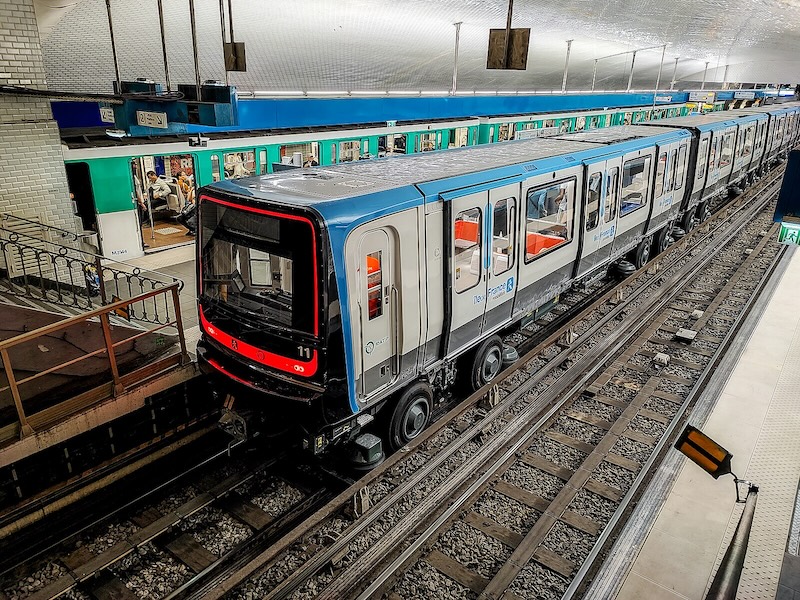
Line 14 extension
The second extension will also double the length of an existing line. This time, it’s line 14. The 14 opened in 1998 as a relief line on Paris’s busy east-west axis, offering fast travel times between the 13th arrondissement and the 8th, via the Gare de Lyon and Châtelet. It’s since been extended three times, including a major northern extension at the end of 2020 serving the rapidly developing Clichy-Batignolles neighbourhood and the town of Saint-Ouen. The line measured 8.6 km in 2020. Today, it’s 14.5 km long. But from June this year, line 14 will span 30 km, making it, by a large margin, Paris’s longest metro line. The extension will take trains south all the way to Orly airport, and one stop north to Saint-Denis. It will thus carry visitors to the heart of the summer’s Olympic Games.
Like on line 11, new trains have been introduced to prepare for the extension. These new 8-car vehicles are the self-driving version of the MP 14s now on line 11, and replaced 6-car trains which have been handed down to line 4. The last of these was delivered in March 2023.
Line 4 automation
The first self-driving trains arrived on line 4 in December 2022, from which time they spent a year sharing the line with human-driven stock. Last month, the process was finally completed. Work is still underway to modernise some stations, and the automation needs some fine-tuning. But there are no more human drivers on the line.
New trains on line 6
The automation of line 4 left behind some human-driven trains with plenty of life left in them. The MP 89 was introduced on line 1 in the late 1990s, and passed down to line 4 in 2011, when line 1 was automated. Now, they are being refurbished and reduced in length for use on line 6, replacing MP 73 trains which have been in service since 1974. The first hand-me-downs were delivered in January 2023; as of December, 10 of line 6’s 45 trains had been replaced.
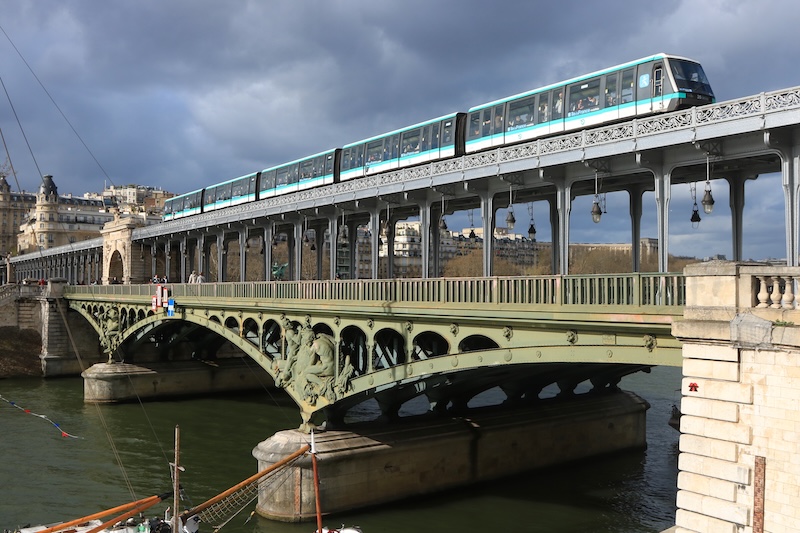
Fare shenanigans
To close, let’s talk about fares. Visitors to Paris during this summer’s Olympic and Paralympic games will have to pay a lot more than usual for public transport. A single metro/bus ticket will cost €4 instead of €2.15; and a weekly pass will cost €70 instead of €30.75. This has proven deeply controversial, especially since the original Olympic bid promised free transport to those with tickets to events. But the extra service being laid on for the Games – a 15% increase – will cost €200 million. The idea behind the measure is to make visitors pay for that increase in service, without hitting locals’ pockets. Parisians on monthly or annual passes are unaffected, as are those with the Navigo Liberté+, which bills passengers monthly for their usage the previous month. Those who only ride occasionally can also simply stock up in advance.
Transit fares in the Paris region are anything but straightforward. Next time, I will dive more deeply into how we pay for public transport here. After that, we will close out this series with a look at what’s changing in the realm of personal transport: driving and active travel. Stay tuned by signing up for email updates below.
-
What distinguishes RER and Transilien lines is that the RER’s trains run through tunnels in, and usually across, central Paris, whereas Transilien services run into Parisian terminals or, as in the case of the U and the new V, avoid the city proper entirely. ↩
 Fabric of Paris
Fabric of Paris